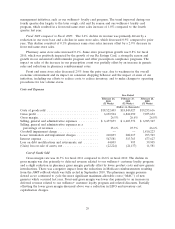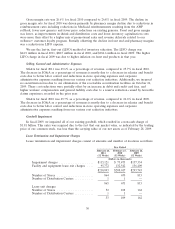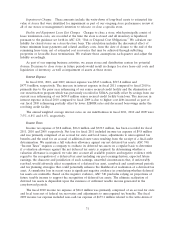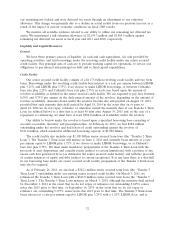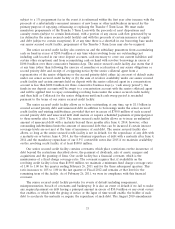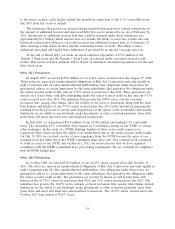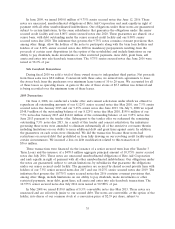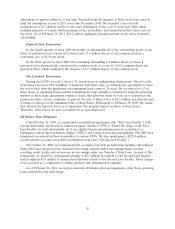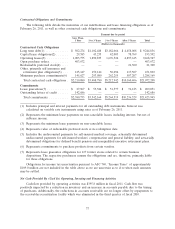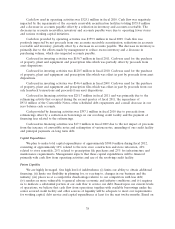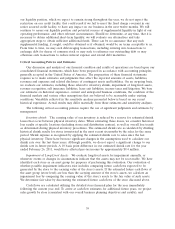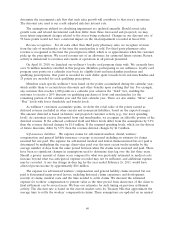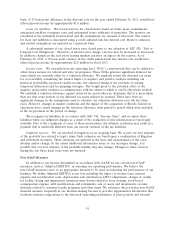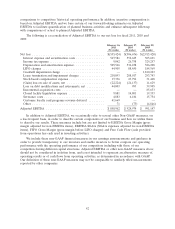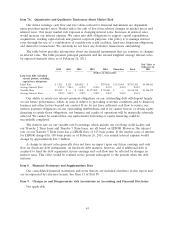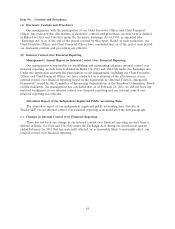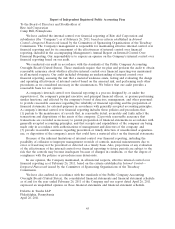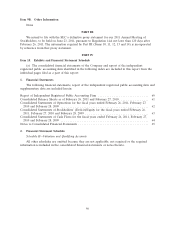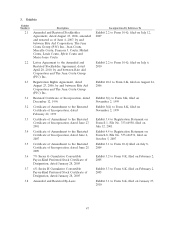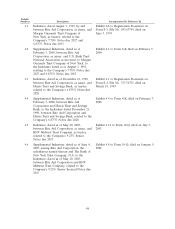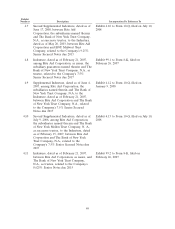Rite Aid 2011 Annual Report Download - page 39
Download and view the complete annual report
Please find page 39 of the 2011 Rite Aid annual report below. You can navigate through the pages in the report by either clicking on the pages listed below, or by using the keyword search tool below to find specific information within the annual report.our liquidity position, which we expect to remain strong throughout the year, we do not expect the
restriction on our credit facility, that could result if we fail to meet the fixed charge covenant in our
senior secured credit facility, to have any impact on our business in the next twelve months. We will
continue to assess our liquidity position and potential sources of supplemental liquidity in light of our
operating performance, and other relevant circumstances. Should we determine, at any time, that it is
necessary to obtain additional short-term liquidity, we will evaluate our alternatives and take
appropriate steps to obtain sufficient additional funds. There can be no assurance that any such
supplemental funding, if sought, could be obtained or if obtained, would be on terms acceptable to us.
From time to time, we may seek deleveraging transactions, including entering into transactions to
exchange debt for shares of common stock or may seek to refinance our outstanding debt or may
otherwise seek transactions to reduce interest expense and extend debt maturities.
Critical Accounting Policies and Estimates
Our discussion and analysis of our financial condition and results of operations are based upon our
consolidated financial statements, which have been prepared in accordance with accounting principles
generally accepted in the United States of America. The preparation of these financial statements
requires us to make estimates and judgments that affect the reported amounts of assets, liabilities,
revenues and expenses and related disclosure of contingent assets and liabilities. On an on-going basis,
we evaluate our estimates, including those related to inventory shrink, impairment of long-lived assets,
revenue recognition, self insurance liabilities, lease exit liabilities, income taxes and litigation. We base
our estimates on historical experience, current and anticipated business conditions, the condition of the
financial markets and various other assumptions that are believed to be reasonable under existing
conditions. Variability reflected in the sensitivity analyses presented below is based on our recent
historical experience. Actual results may differ materially from these estimates and sensitivity analyses.
The following critical accounting policies require the use of significant judgments and estimates by
management:
Inventory shrink: The carrying value of our inventory is reduced by a reserve for estimated shrink
losses that occur between physical inventory dates. When estimating these losses, we consider historical
loss results at specific locations (including stores and distribution centers), as well as overall loss trends
as determined during physical inventory procedures. The estimated shrink rate is calculated by dividing
historical shrink results for stores inventoried in the most recent six months by the sales for the same
period. Shrink expense is recognized by applying the estimated shrink rate to sales since the last
physical inventory. There have been no significant changes in the assumptions used to calculate our
shrink rate over the last three years. Although possible, we do not expect a significant change to our
shrink rate in future periods. A 10 basis point difference in our estimated shrink rate for the year
ended February 26, 2011, would have affected pre-tax income by approximately $9.4 million.
Impairment of Long-Lived Assets: We evaluate long-lived assets for impairment annually, or
whenever events or changes in circumstances indicate that the assets may not be recoverable. We have
identified each store as an asset group for purposes of performing this evaluation. Our evaluation of
whether possible impairment indicators exist includes comparing future cash flows expected to be
generated by the store to the carrying value of the store’s assets. If the estimated future cash flows of
the asset group (store level) are less than the carrying amount of the store’s assets, we calculate an
impairment loss by comparing the carrying value of the store’s assets to the fair value of such assets.
We determine fair value by discounting the estimated future cash flows of the store discussed above.
Cash flows are calculated utilizing the detailed store financial plan for the year immediately
following the current year end. To arrive at cash flow estimates for additional future years, we project
sales growth by store (consistent with our overall business planning objectives and results), and
39


